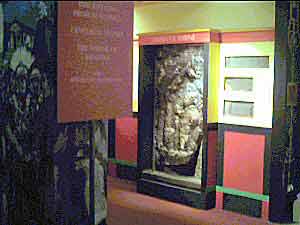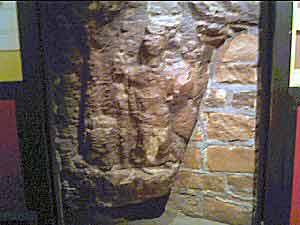 |  | |
|
Home |
Hotels | Guest Houses |
Chester Events |
Visiting Chester |
Parking |
Shopping |
Business |
Chester Pubs |
Restaurants |
Tickets |
Chester Live! |
Community |
Contact Us |


|
Located on the ground floor of the Grosvenor Museum is the Graham Webster Gallery. This gallery contains a fine collection of Roman tombstones recovered from the city walls during repair work to the north east corner in 1887 and 1883 - 1892. They were found in the interior of the lower part of the wall between the Northgate and King Charles Tower. They date from the founding of the fortress to the mid third century. It is thought that the Romans themselves used them to repair the walls late in the Roman period. The carving on many is crisp, and it shows that they were not left exposed to the weather for a long time.


Roman Altars
As you first enter the gallery from the main hall you come across a display of four Roman altars recovered from Chester at various times. The first altar on the left is shown in a reconstructions of an Optio's quarters to the left of the altars.
Inside is shown the Optio with a copy of the altar that has been painted to represent how it would have looked in Roman times.

Four Roman Altars on display


Reconstruction of the Optio's quarters. With the reconstructed altar in place. If you press the button the display talks.
The Aelius Claudianus Altar


The inscription reads as follows:
'Genio Sancto centurie Aelius Claudian optio votum solvit'
'Aelius Claudianus, optio, pays his vow to the Genius of his Century'
The Flavius Longus Altar




The inscription reads as follows:
'Genio Sancto centurie Aelius Claudian optio votum solvit'
'Aelius Claudianus, optio, pays his vow to the Genius of his Century'
The Flavius Longus Altar




A very fine altar decorated on all its faces. On one side are leaves and a vase of fruit; on the other is a genius (guardian spirit) stands by an altar holding a horn of plenty. On the top of the altar where offerings were poured is a face looking upwards. On the back is a curtain with fruit held in the folds of the material.
The inscription reads:
"For the safety of our lords, the most invincible Emperors, dedicated to the guardian spirit of the place by Flavius Longus, military tribune of the Twentieth Legion Valeria Victrix, and by his son Longinus (both) from Samosata, in fulfilment of their vow"
A military tribune was one of the six junior officers attached to each legion, Samosata (modern Samsat) is on the upper reaches of the River Euphrates in modern Turkey. The Emperors are most likely to be Septimius Severus and his son Caraclla (AD 198- 211).
The altar was found in 1693 sixty yards inside the Eastgate.
The Greek Doctors altar


An altar set up by a Greek doctor. This man may have been the legion's medical officer, of the personal Physician of the commander (legatus)
The inscription is in Greek.
"Antiochus the doctor honoured those among the immortals who are the all surpassing saviours of man, Asklepios of the gentle hands, Hygenia and Panakela".
Asklepios was the god of medicine and healing. Hygenia was the goddess of good health, from whom we get our word "hygiene", and Panakela was the all-healing goddess whose name we use in its Latin form, "panacea", to mean a cure for all ills.
In the Roman army doctors were normally recruited from the Greek speaking eastern part of the empire. Antiochus probably came from an area in what we now call Turkey. The language he has used on this altar is very poetic; perhaps he was taking the opportunity to show off his culture and learning to the more down-to-earth Romans with whom he worked. The altar was found in February 1968 during excavations on the site of the Old Market Hall in the centre of Chester.
The Nemesis Altar




This small altar was found in situ in the 'Nemeseum', a room in the Amphitheatre. The inscription reads :
DEAE NEMESI SE_T - MARCI ANVS V S - EX VISV
("Dedicated to the goddess Nemesis by Se_tus Marcianus, after a dream.")



Next to the reconstruction of the Optio's quarters is a cremation urn discovered in Handbridge.
Click on the picture to find out more.

The Roman Stones


On the Left hand Side
Next is the main display area. The Roman tomb stones are arranged on either side of a walk way. With descriptions on the stones below. The stones are numbered starting on the left as you come in. The stones are described in this order. There is an information panel about the discovery of the stones on the left at the end of the display.

Information panel on the discovery of the stones.
Stone 1
G:CALVENTIVS G:F:CLAVD:CE LER:APRO:MIL LEG:II:AD:P:F VIBI:CLEME[NTIS
'Gaius Calventivs Celer son of Gaius, of the Caludian voting tribe from Aprus a soldier of the second legion Adiutrix loyal and faithful of the century of Vibius Clemens (Aprus was a town in Thrace ,a district now covered by North-Eastern Greece and European Turkey)
Stone 2
D:MP:RVSTO:FABIA:CRESCEN:BRIX:MIL:LEG XX VV AN XXX STIP X GROMA HERES FAC CVR
'To the spirits of the departed and to Publius Rustius Crescens of the Fabian voting tribe from Brixia, Soldier in the twentieth legion Valeria Victrix. He Lived for 30 years and served for 10 years. Groma his heir had this stone made. (Brixia is now Brescia in Northern Italy)
Stone 3
DM CAECILIUS:AVIT:VS:EMER:AVG:OPTIO LEG XX VV STP XV:VIX AN XXXIIII HFC
'To the spirits of the departed Caecilius Auitus of Emerita Augusta, An Optio of the twentieth legion Valeria Victrix served 15 years and lived for 34 years, His heir had this stone made. (Emerita Augusta is now Merida in South-Western Spain)
This fine complete stone shows am Optio. He was a junior officer second in rank to a centurion, whose duties included some of the book keeping for the century. He is dressed in a heavy cloak (Sagum) and wears a legionary sword at his side. In his right hand he carries a staff of office, while in his left hand he holds a writing tablet.
Stone 7
At the top of the stone there is a portrait of the dead man. On either side are the heads of two lions, each with its mouth wide open and the head of a ram in its paws. Lions are commonly shown on Roman tombs. They are a symbol of the suddenness by which life can be turned into death.
It has a fragment of inscription :SE_TVS:SE_TI:FILIVS
FAB:BRIX[IA...
SIMIL[...
This means : 'Se_tus Simil(?ius), Son of Se_tus, of the Fabian voting tribe, from Brixia...
Brixia is now Brescia in Northern Italy.
Stone 8
The 'Shipwreck' Stone
OPTIONIS:AD:SPEM:ORDINIS>LVCILI INGENVI QUI NAVFRAGIO PERIT SE
... Optio Ad Spem Ordinis in the century of Lucilius Ingenus, who died by shipwreck. He is buried ?....
An Optio ad spem ordinis was an Optio who was designated for promotion to the rank of Centurion.
Note that the letter H standing for 'Hic' or 'Here' is missing from the normal formula H.S.E. Hic Situs Est 'He is laid here'. This indicates that the body was never found. They perhaps left the 'Here' out in the hope of one body recovering the body. But it looks like it never was found.

Stone 9
D:M M:AVR:NEPOS:>:LEG XX:V:V:CONIVX PIENTISSIMA:F:C VIX:ANNIS:L
'To the spirits of the departed, Marcus Aurelius Nepos, Centurion of the Twentieth Legion Valeria Victrix. His most dutiful wife had this made. He lived for 50 years.
This is a memorial stone to a centurion and his wife. Dating from the second or early third century AD. He holds a vine staff, a symbol of his office. A space was left for a epitaph for his wife. But this was never completed. On the side of the stone are carved a mason's hammer and set square. There are also the words 'SVB ASCIA D[EDICATVM' which translates as 'Dedicated while under the axe'. This is believed to be a religious formula to deter people from vandalising the grave.
Stone 10


Stone 11
The 'Imaginifer' Stone.
The above stone is the tombstone of a Roman Imaginifer of the twentieth legion. This Roman soldier was paid to carry the head of the reigning emperor made out of metal around on a long pole with handles. The top of the stone is missing. But you can see the soldier on the right. And on the left the bust of the emperor on a pole with two handles at the bottom.

A Roman tomb stone commemorating a 'veterantis'. (A soldier who had completed his term in service to the legion)
The inscription reads : G VALERIO CRISPO VETRANO EX LEG II AD PIA...
Stone 14

On the right hand side









Stone 25
Stone 26
Stone 27
Stone 28
The 'Ecclesiastical' Stone
A small stone shows two ladies probably a mistress and her maid servant. One holds a mirror and the other a jewel box. The panel may be one of a series showing various scenes of family life. In the nineteenth century this stone was nicknamed the Ecclesiastical stone because it was thought that the figures were a medieval priest and his assistant.







The Centurial Stones
This collection of three weathered plaques appear to have come from the fortress wall. They indicate who constructed each section.

Stone 47
COH:I:C:OCRATI MAXIMI:LMP
Built by the century of Ocratius Maximus in the first cohort of the legion.

Stone 48
C:Q:MAX
Built by the century of Quintus Maximus

Stone 49
C:T:FLAVI CICATRICULA
Built by the century of Titus Flavius Cictricula
The Minerva Shrine
To the left of the centurial stones is a reconstruction of the Minerva Shrine. The original is still on view in Handbridge. Click on the picture for more information.




There is also an interactive computer display and books for further information on the Roman Stone collection.

The Exit
The exit leads to the shops and number 20 Castle Street. A house with each room reconstructed in a period of its history.

More about Chester Roman Inscriptions from www.roman-britain.org
Roman remains insitu
This page was last updated

